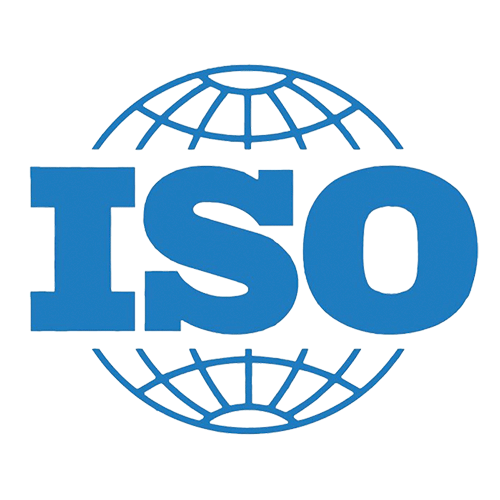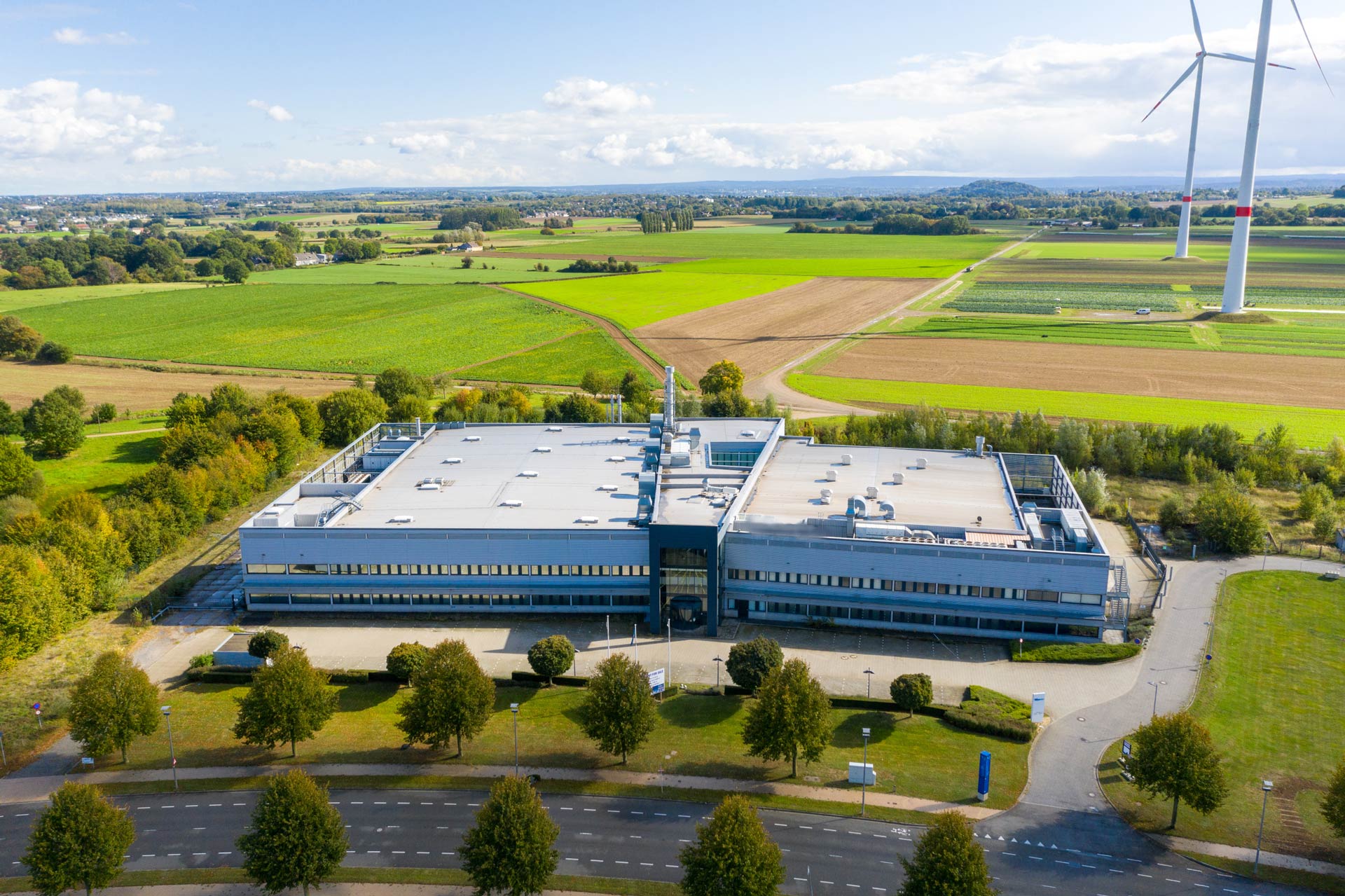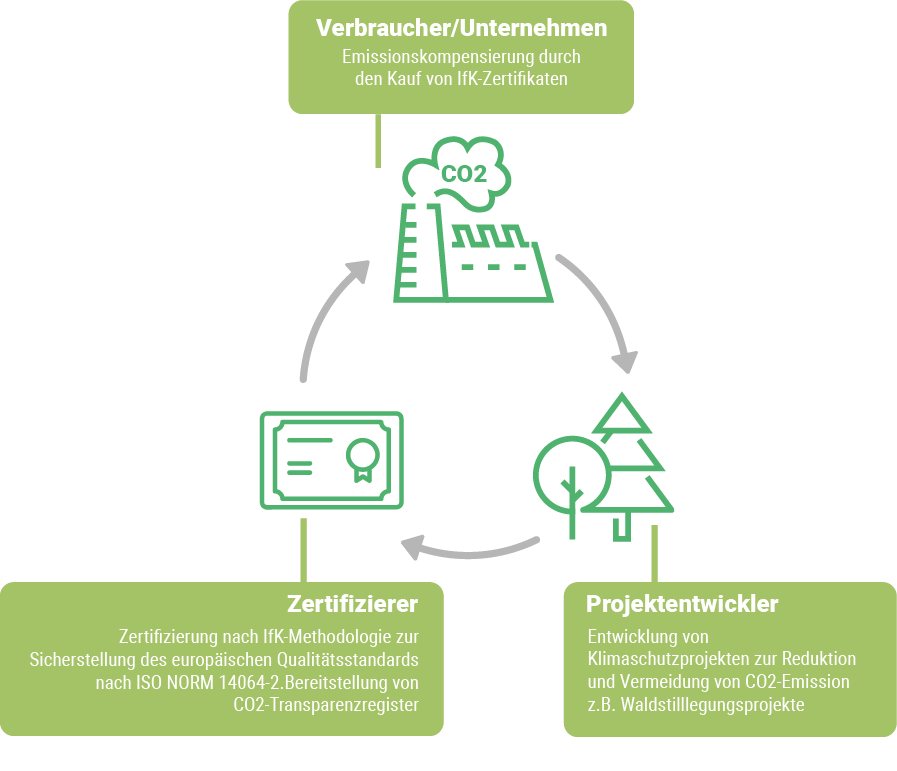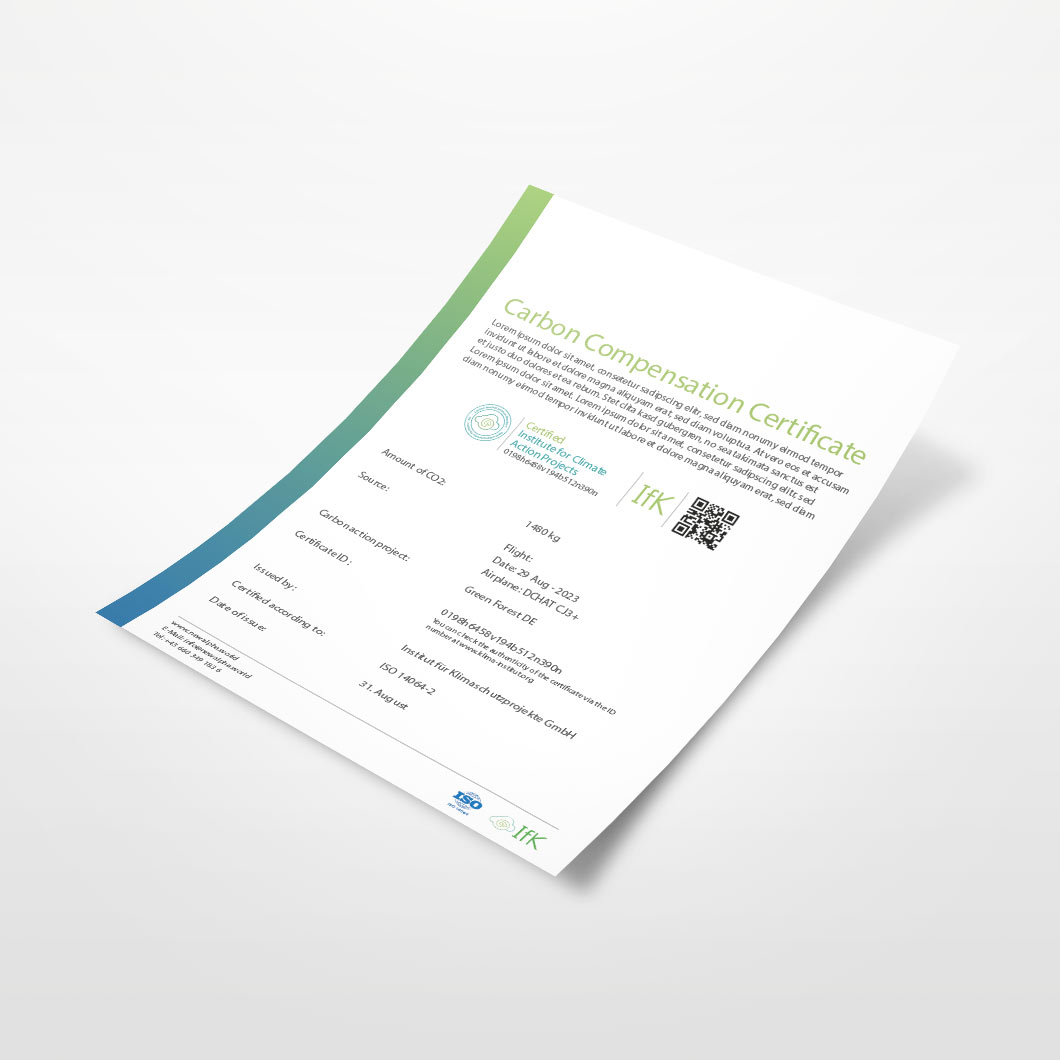CO2 certificates
We support you in certifying your EU climate protection projects and ensure security through the IfK
CO2 Transparency Register.
We support you in certifying your EU climate protection projects and ensure security through the IfK
CO2 Transparency Register.

EU Climate Protection Projects according to DIN-ISO Standard 14064-2

Certified under the supervision of TÜV
Secured by our blockchain-based CO2 Transparency Register
The Institute for Climate Protection Projects (IfK) GmbH is an independent entity rooted at RWTH Aachen, with Prof. Dr. Achim Kampker, the inventor of the electric vehicle "StreetScooter" (utilized by Deutsche Post among others), as one of its co-founders. The institute specializes in the development, verification, and certification of European climate protection projects with the goal of promoting and supporting the reduction of greenhouse gas emissions.
Our experienced team of experts has extensive knowledge in the fields of climate protection, emissions trading, and sustainability. We offer our clients comprehensive consulting and support in the development and implementation of climate protection projects that comply with the strict DIN-ISO Standard 14064-2.

Our services include the verification of German and European climate protection projects according to DIN-ISO Standard 14064-2. We work closely with our clients to ensure that their projects meet the highest standards and comply with the requirements of international climate protection agreements. Furthermore, TÜV, an independent third party, audits our certified IfK projects.



Learn more

Learn more
Reforestation refers to the targeted planting of saplings in cleared or damaged areas to regenerate forests and restore ecological balance. This measure protects biodiversity, conserves water reservoirs, and absorbs CO2, contributing to the fight against climate change. Reforestation creates essential habitats and promotes sustainable resource use.

Learn more
By preventing deforestation, more CO2 is stored, particularly as mature forests of about 30 years, already sequester more carbon than newly planted areas, supporting the United Nations' Net Zero Strategy. These sink areas, safeguarded for a duration ranging from 30 to 75 years, are guaranteed against industrial use.
The CO2 certificates generated from these preserved forests are available for companies seeking to offset their carbon emissions.

Learn more
The pyrolysis process for binding CO2 is a chemical process in which organic materials such as biomass or waste are heated in a low-oxygen environment. This leads to the splitting of these materials into solid carbon structures, liquid biomass oils, and gaseous products. During the process, carbon is permanently bound in the solid carbon residue, helping to remove CO2 from the atmosphere while producing versatile products like biochar and biocoal that can be used in various sustainable applications.
Reforestation refers to the targeted planting of saplings in cleared or damaged areas to regenerate forests and restore ecological balance. This measure protects biodiversity, conserves water reservoirs, and absorbs CO2, contributing to the fight against climate change. Reforestation creates essential habitats and promotes sustainable resource use.
By preventing deforestation, more CO2 is stored, particularly as mature forests of about 30 years, already sequester more carbon than newly planted areas, supporting the United Nations' Net Zero Strategy. These sink areas, safeguarded for a duration ranging from 30 to 75 years, are guaranteed against industrial use.
The CO2 certificates generated from these preserved forests are available for companies seeking to offset their carbon emissions.
The pyrolysis process for binding CO2 is a chemical process in which organic materials such as biomass or waste are heated in a low-oxygen environment. This leads to the splitting of these materials into solid carbon structures, liquid biomass oils, and gaseous products. During the process, carbon is permanently bound in the solid carbon residue, helping to remove CO2 from the atmosphere while producing versatile products like biochar and biocoal that can be used in various sustainable applications.
With the latest Web3 blockchain technology, IfK ensures that your certificate can be uniquely identified, guaranteeing the transparency and integrity of certificate trading.
The standard of certification indicated on the certificate not only complies with stringent environmental standards but also showcases your dedication to fostering a sustainable future.

Learn more
In the past, there have been multiple instances where CO2 certificates were sold twice. This leads to emissions being presented as compensated even though they are not.
To avoid this and to provide everyone with an accurate overview of our projects and compensated emissions, we use blockchain. It allows us to store information authentically and transparently for everyone to see.
to receive individual consultation on our solutions
and have it certified by our experts
on the CO2 Transparency Register
We are convinced that only through collaboration between companies, governments, and society as a whole can a sustainable future be achieved. We work closely with our clients and partners to develop and implement innovative solutions together. In doing so, we pay attention to regional references to ensure high transparency.

CEO IfK

Director PEM RWTH Aachen, 1st Chairman of Engineers Save the Earth

Co-Founder IfK, Serial Entrepreneur in sustainability (e.g., greenAir)
Marcus Stawitzki
CEO, Institute for Climate Protection Projects GmbH
Climate change is a global challenge that requires collective action, prompting the United Nations to launch the Net Zero Strategy. The goal of the Net Zero Strategy is to reduce greenhouse gas emissions by 2050 so that the net output of CO2 is zero (Net Zero).
Net Zero concepts include firstly, the reduction of avoidable emissions and the compensation of remaining emissions through CO2 climate protection projects.
IfK specializes in the certification and support of CO2 compensation projects.

Model of a Compensation Project
CO2 certificates play a crucial role in climate protection by offsetting greenhouse gas emissions, thereby mitigating climate change. These certificates are issued based on the amount of CO2 stored through climate protection projects.
Companies or organizations can purchase these certificates to neutralize their own CO2 emissions, enhancing their carbon balance and facilitating the achievement of their climate objectives.
IfK certificates are generated from European climate projects and are certified according to the international standard DIN EN ISO 14064-2 to ensure that they meet the highest requirements. The certificates are traded on the voluntary CO2 market.



The Chair of "Production Engineering of E-Mobility Components" (PEM), led by Prof. Dr. Achim Kampker, holds key positions in numerous research projects that are funded nationally and internationally. The focus is primarily on reducing emissions in the mobility sector.

TÜV's highly skilled experts globally test technical systems and products while supporting technological and business innovations. Acting as a neutral entity, TÜV conducts audits on forest projects that are implemented in accordance with ISO Standard 14064-2.

The Humanotop Avantis project, initiated by the Engineers Save the Earth e.V. association, exemplifies a model business park that generates all necessary resources within its geographical area. Engineers Save the Earth e.V. promotes for innovative solutions and technologies that are not merely CO2 neutral, but in some instances, are CO2 positive.

Based in Geneva, ISO (International Organization for Standardization) is the entity our projects align with, as the CO2 certificates we issue strictly adhere to the DIN-ISO Standard 14064-2. This particular standard, endorsed by the German Federal Environment Agency among others, is one of the most important quality standards for certificate trading.
CO2-Zertifikate werden verwendet, um Emissionen zu kompensieren. Sie werden beispielsweise durch die Stilllegung von Waldflächen, welche dann CO2 aufnehmen und speichern können, generiert. Diese Zertifikate können dann von Personen oder Unternehmen erworben werden, um CO2-Emissionen auszugleichen.
Für weitere Informationen klicken Sie hier um zu einem Dokument des Umwelbundesamtes zu gelangen.
Sowohl VERs, als auch CERs sind Zertifikatstypen.
CERs (Certified Emission Reductions) sind zertifizierte Einheiten, die im Clean Development Mechanism (CDM) gemäß dem Kyoto-Protokoll entstehen. Sie resultieren aus Projekten in Entwicklungsländern zur Emissionsminderung, sind handelbar und ermöglichen Industrieländern, ihre eigenen Emissionsverpflichtungen zu erfüllen, indem sie diese zertifizierten Reduktionen anrechnen lassen.
VERs (Verified Emission Reductions) stammen aus Projekten mit unabhängiger Verifizierung, welche jedoch am CDM-Standard orientiert ist. Sie werden auf dem freiwilligen Martk gehandelt.
Bei VERs (Verified Emission Reductions) gibt es verschiedene Zertifikatsstandards, die sicherstellen sollen, dass die erzielten Emissionsminderungen korrekt gemessen, überwacht und verifiziert werden.
1. Gold Standard: Der Gold Standard ist ein strenger Zertifikatsstandard, der hohe Anforderungen an Klimaschutzprojekte stellt. Er legt nicht nur Wert auf Emissionsreduktionen, sondern auch auf soziale und nachhaltige Entwicklungseffekte.
2. Verified Carbon Standard (VCS): Der Verified Carbon Standard ist ein international anerkannter Standard für Emissionsreduktionsprojekte. Er legt detaillierte Richtlinien für die Überwachung, Berichterstattung und Verifizierung von Emissionsreduktionen fest.
3. Climate Action Reserve (CAR): Dies ist ein Standard, der hauptsächlich in den USA angewendet wird. Er konzentriert sich auf Projekte zur Minderung von Treibhausgasen und bietet genaue Richtlinien für die Erfassung von Emissionsreduktionen.
4. Plan Vivo: Dieser Standard legt besonderen Wert auf Projekte, die die Lebensgrundlage lokaler Gemeinschaften stärken und gleichzeitig den Klimawandel bekämpfen. Er betont die Bedeutung der nachhaltigen Entwicklung.
5. Social Carbon: Ähnlich wie Plan Vivo setzt dieser Standard den Schwerpunkt auf soziale und ökonomische Vorteile für lokale Gemeinschaften. Er bezieht sich auf Projekte, die die Lebensqualität verbessern und gleichzeitig Emissionen reduzieren.
1. Zertifikatsstandard prüfen: Überprüfe, ob die Zertifikate gemäß anerkannten Standards wie dem Gold Standard, dem Verified Carbon Standard (VCS) oder anderen seriösen Standards ausgestellt wurden. Diese Standards legen klare Kriterien für die Messung, Überwachung und Verifizierung von Emissionsminderungen fest.
2. Projektintegrität prüfen: Informiere dich über das Projekt, aus dem die Zertifikate stammen. Achte darauf, dass das Projekt gut dokumentiert ist und nachweislich reale und nachhaltige Emissionsreduktionen erzielt hat.
3. Unabhängige Überprüfung: Achte darauf, dass die Emissionsminderungen von unabhängigen und akkreditierten Prüfstellen überwacht und verifiziert wurden. Dies gewährleistet eine unvoreingenommene Beurteilung der erzielten Reduktionen.
4. Transparenz: Stelle sicher, dass die Informationen über das Projekt und die Emissionsminderungen transparent und öffentlich verfügbar sind. Seriöse Projekte und Anbieter legen ihre Daten offen, um ihre Glaubwürdigkeit zu unterstreichen.
5. Beratung einholen: Wenn du unsicher bist, ziehe Experten oder Berater im Bereich Klimaschutz und Emissionshandel hinzu, um sicherzustellen, dass du qualitativ hochwertige Zertifikate erwirbst.
Für weitere Informationen klicken Sie hier um zu einem Dokument des Umwelbundesamtes zu gelangen.
Der Ablauf des freiwilligen Zertifikat-Handels kann folgendermaßen aussehen:
1. Projektentwicklung: Ein Klimaschutzprojekt wird initiiert, das darauf abzielt, Treibhausgasemissionen zu reduzieren oder zu verhindern. Dies kann beispielsweise die Förderung erneuerbarer Energien, Energieeffizienzmaßnahmen oder Aufforstungsprojekte umfassen.
2. Messung und Verifizierung: Die Emissionsreduktionen des Projekts werden gemessen und von unabhängigen Stellen überprüft, um sicherzustellen, dass sie real und nachhaltig sind.
3. Ausstellung von Zertifikaten: Für jede nachgewiesene Emissionsminderung wird ein Emissionsminderungszertifikat ausgestellt. Diese Zertifikate repräsentieren eine bestimmte Menge an reduzierten Treibhausgasen.
4. Marktplatz oder Plattformen: Es gibt verschiedene Plattformen, Marktplätze oder Händler, auf denen die Zertifikate gehandelt werden können. Hier können Käufer und Verkäufer ihre Zertifikate anbieten oder erwerben.
5. Kauf und Nutzung: Unternehmen oder Einzelpersonen, die ihre CO2-Bilanz ausgleichen möchten, können diese Zertifikate kaufen. Der Kauf von Zertifikaten entspricht dem Engagement, die eigenen Emissionen durch die Unterstützung von Projekten auszugleichen, die Emissionen reduzieren.
Für weitere Informationen klicken Sie hier um zu einem Dokument des Umwelbundesamtes zu gelangen.
Ex post und ex ante sind Begriffe, die im Zusammenhang mit der Messung und Überprüfung von Emissionsminderungen verwendet werden und sich auf verschiedene Zeitpunkte beziehen:
Ex post bezieht sich auf eine Bewertung oder Überprüfung, die nachträglich erfolgt. Ex post-Zertifikate werden ausgestellt, nachdem die Emissionsminderungen tatsächlich erreicht wurden und gemessen und überprüft worden sind.
Ex ante bezieht sich auf eine Bewertung oder Schätzung, die im Voraus erfolgt. Ex ante-Zertifikate werden auf Basis von erwarteten Emissionsminderungen ausgestellt, bevor diese tatsächlich erreicht wurden.
Für weitere Informationen klicken Sie hier um zu einem Dokument des Umwelbundesamtes zu gelangen.
Europäische Waldprojekte bieten aufgrund ihrer einfacheren Verifizierung eine höhere Transparenz und Integrität.
Für weitere Informationen klicken Sie hier um zu einem Dokument des Umwelbundesamtes zu gelangen.
Das IfK zertifiziert Klimaschutzprojekte nach DIN EN ISO 14064-2.
Für weitere Informationen klicken Sie hier um zu einem Dokument des Umwelbundesamtes zu gelangen.
Bei der Bewertung und Auswahl von Klimaschutzprojekten sollten mehrere Faktoren berücksichtigt werden, um sicherzustellen, dass sie effektiv, nachhaltig und glaubwürdig sind.
1. Zertifizierungsstandards: Stellen Sie sicher, dass das Projekt nach anerkannten Zertifizierungsstandards durchgeführt wird, die klare Richtlinien für die Messung, Überwachung und Verifizierung von Emissionsreduktionen vorschreiben, wie beispielsweise dem Verified Carbon Standard (VCS) oder dem Gold Standard.
2. Messbarkeit und Verifizierbarkeit: Das Projekt sollte in der Lage sein, die tatsächlichen Emissionsreduktionen klar zu messen und zu überprüfen. Unabhängige Überprüfungen durch akkreditierte Prüfstellen sind wichtig, um die Glaubwürdigkeit zu gewährleisten.
3. Nachhaltigkeit: Berücksichtigen Sie, ob das Projekt langfristig nachhaltige Auswirkungen hat, nicht nur kurzfristige Reduzierungen. Es sollte sichergestellt werden, dass das Projekt nicht zu negativen Umweltauswirkungen oder sozialen Problemen führt.
Für weitere Informationen klicken Sie hier um zu einem Dokument des Umwelbundesamtes zu gelangen.
Eine Blockchain ist eine dezentrale, digitale Datenbank-Technologie, die Informationen in Blöcken speichert und diese miteinander verknüpft, um eine unveränderliche und transparente Aufzeichnung von Transaktionen oder Daten zu gewährleisten.
Mit dieser Technologie können wir sicherstellen, dass Zertifikate nur ein Mal ausgestellt werden können und es kann jeder Zeit geprüft werden, wo das Zertifikat seinen Ursprung hat.
Das CO2-Transparenzregister ist die Technologie, die es möglich macht die Integrität der Zertifikate sicherzustellen und ihren Ursprung zu prüfen.
Durch das CO2-Transparenzregister ist es jedem möglich ein Zertifikat auf seinen Ursprung zu prüfen. Dadurch kann einfach verifiziert werden, dass Zertifikate nicht doppelt ausgestellt werden.